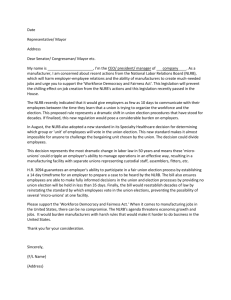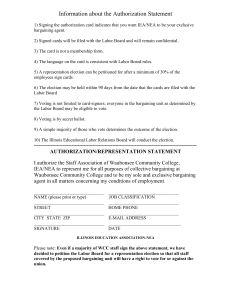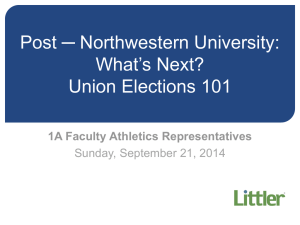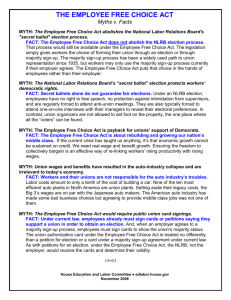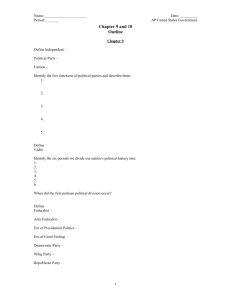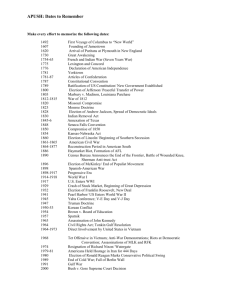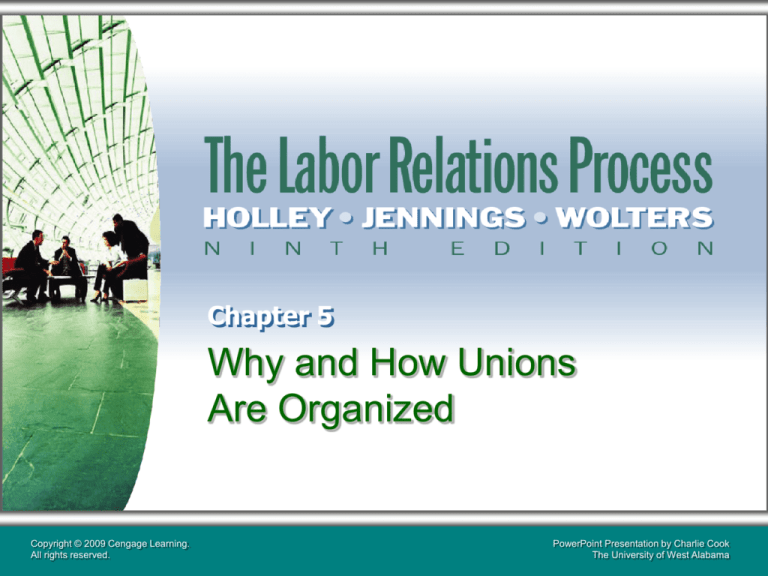
Chapter 5
Why and How Unions
Are Organized
Copyright © 2009 Cengage Learning.
All rights reserved.
PowerPoint Presentation by Charlie Cook
The University of West Alabama
Why Unions Are Formed
• Work and Job Conditions Explanation
Alienation Theory—the influence of machinery
Loss of personal contact with labor and products produced
Loss of personal involvement in the work
Pace of work estranging workers from each other
Scarcity Consciousness Theory—jobs are difficult to
obtain and retain
Employees believe unions protect jobs by:
– Negotiating work rules and apprenticeship programs.
– Bargaining seniority and layoff provisions.
– Agreeing to grievance procedures.
– Lobbying for legislation to protect worker rights and jobs.
© 2008 Cengage Learning. All rights reserved.
5–2
Why Unions Are Formed (cont’d)
• Work and Job Conditions Explanation (cont’d)
Wheeler Model of Union Formation
First stage: individual worker’s readiness to take aggressive
action to express anger at the employer that results from:
– Fear of deprivation of current work benefits.
– Frustration with not being heard as an individual.
– Rational calculation that the benefits of unionization outweigh its
costs.
Second stage: individual workers form a group and decide to
take collective action.
– Saliency: the workers’ belief that the union can facilitate
resolution of their problems.
© 2008 Cengage Learning. All rights reserved.
5–3
Wheeler Model of Union Formation
Second Stage:
Decision to take
collective action
First Stage:
Readiness to
take action
Decision not
to unionize
Love
(Group cohesion)
Fear of
deprivation
Fear of
punishment
Hope
(Belief in unions)
Frustration of not
being heard
Lack of belief
in unions
Saliency
(Resolution)
Rational
calculation
Withdrawal
and/or revenge
© 2008 Cengage Learning. All rights reserved.
5–4
Why Unions Are Formed (cont’d)
• Employee Backgrounds and Needs
Previous experience as a union member generally
results in a favorable attitude towards unions.
Union member parents’ attitudes and family
experiences strongly influence positive union
attitudes.
Unions help satisfy the interrelated social needs of
members for identity, self-esteem, and affiliation.
© 2008 Cengage Learning. All rights reserved.
5–5
Exhibit 5.1
Influences on Employees on Whether to Vote For
or Against a Union
© 2008 Cengage Learning. All rights reserved.
5–6
The Union’s Challenge of Organizing
the Diverse Workforce
• The Changed Workforce
Temporary (contingent) employees
Permanent part-time employees
Independent contractors
Leased workers
Minorities (racial and ethnic)
Immigrant (legal and illegal) workers
Older workers
Higher-skilled workers
© 2008 Cengage Learning. All rights reserved.
5–7
The Union’s Challenge of Organizing the
Diverse Workforce
• A Changing Workplace
Declines in unions’ stronghold industries
Increases in service industries workers
Increases in industries with skilled workers
Outsourcing
Globalization
© 2008 Cengage Learning. All rights reserved.
5–8
Organizing Professional Employees
• Arguments
Against the organization of professionals:
Unionization represents a rejection of professional values.
For the organization of professionals:
Unionization helps achieve and maintain professional values.
• Issues in Collective Bargaining:
Professional standards
Participation in policy making
Regulation of professional work
Training and professional development
Commitment of organizational resources to professional goals
Criteria for personnel decisions regarding professionals
© 2008 Cengage Learning. All rights reserved.
5–9
Activities of Union in Organizing Employees
• Union Actions
Don’t initiate organizing; rather it responds to
employees’ request for assistance in organizing.
Emphasize the benefits of collective bargaining and
grievance procedures to relieve employee
dissatisfaction and fears.
• Roles of Union Organizers
Educator: union benefits/protections, labor traditions
Persuader: encourage voting for unionization
Supporter: support workers’ collective actions
© 2008 Cengage Learning. All rights reserved.
5–10
Exhibit 5.3
Union Strategy and Courses of Action to Achieve Employee Goals
and Resolve Job-Related Concerns
Examples of Work-Related Problems
and Employee Concerns
Actions by Unions to Encourage
Employees to Join Union
Relations between employees and
management are poor.
Union will represent the interests of employees
to management.
Employees do not trust their employer’s
promises.
Union will negotiate a contract requiring
management to abide by its agreements.
Employees prefer to deal with management as
a group.
Union provides an opportunity for individual
employees to deal as a group with the
employer.
Employees want to have more influence in
workplace decisions.
Union provides a mechanism for influence by
collective bargaining and administering the
agreement.
Employees feel that productivity improvement
would be more effective if employees had more
say in how programs are run.
Union provides a mechanism in which
employees can provide input into those issues
that affect the workplace.
Employees question the effectiveness of the
company’s system for resolving employee
problems and grievances.
Unions typically negotiate a grievance
procedure that provides representation of
employees at each step and hearings before an
outside, neutral arbitrator.
SOURCE: Richard B. Freeman and Joel Rogers, Worker Representation and
Participation Survey, Princeton, N.J.: Princeton Survey Research Associates, 1994.
© 2008 Cengage Learning. All rights reserved.
5–11
Exhibit 5.4
Components of ‘‘Rank-and-File Intensive Strategy’’
That Are Associated with Higher Union Win Rates
1. Use of representative committees to be more in touch with concerns of the
bargaining unit as a whole, to have better access to employees at the workplace
and to demonstrate to the employees that the union Is a democratic and inclusive
organization
2. Person-to-person contact, house calls, and small group meetings
3. Conducting union bargaining surveys, selection of the bargaining committee, and
working with rank and file to develop proposals before election
4. Focus on issues such as dignity, justice, discrimination, fairness, or service quality
5. Serious commitment of staff and financial resources to organizing, involvement of
the international in local campaigns, and training, recruitment, and effective
utilization of rank and file volunteers from already organized bargaining units
6. Use of solidarity days (designated days to wear union buttons, hats, T-shirts, arm
bands, etc.)
SOURCE: Kate Bronfenbrenner, ‘‘The Role of Union Strategies in NLRB Elections,’’ Industrial and Labor Relations Review 50 (January 1997),
pp. 195–211; Kate Bronfenbrenner and Tom Juravich, ‘‘It Takes More Than House Calls: Organizing to Win with a Comprehensive UnionBuilding Strategy,’’ Organizing to Win, eds. Kate Bronfenbrenner, et al. (Ithaca, N.Y.: Cornell University Press, 1999), pp. 33–34.
© 2008 Cengage Learning. All rights reserved.
5–12
Activities of Company in Union Organizing
• Advantages of the Company:
Has full access to its employees.
Can offer possibility of improvement without additional
cost of unionization for employees.
Can benefit from employees’ fear of change.
Lengthy time between successful organization and
issuance of the bargaining order.
© 2008 Cengage Learning. All rights reserved.
5–13
Activities of Company in Union Organizing
(cont’d)
• Effective Campaign Tactics
Hiring labor lawyers and management consultants
Spreading rumors about potential job losses, plant or
store closings
Asking for a “second chance”
• Ineffective Campaign Tactics
Intentionally delaying the representation election
Shifting work and jobs to other facilities
Testing applicants to identify union sympathizers
© 2008 Cengage Learning. All rights reserved.
5–14
Activities of Company in Union Organizing
(cont’d)
• Employer Effects on Elections
Influencing the composition of the bargaining unit
Setting the date for the election
• Illegal Campaign Tactics (Unfair Labor Practices)
Making captive audience speeches after hours
Illegally discharging union supporters and activists
Threatening employees about the consequences of
unionization
© 2008 Cengage Learning. All rights reserved.
5–15
Methods for Organizing Unions
• Voluntary Recognition
The employer pledges to remain neutral and not to
oppose or interfere with the organization campaign.
The employer agrees to a “card check” for union
majority status, allowing the union to forego the NLRB
representation election process.
• Increasing the Success of Organizing Drives
Signing neutrality agreements
Providing lists of employees to the union
Agreeing to place time limits on the organizing
campaigns
© 2008 Cengage Learning. All rights reserved.
5–16
Exhibit 5.5
Basic Union Representation Procedures
Interest
Ways for union
to obtain
recognition
1. Internal: Employees contact union organizer
2. External: Union organizer contacts employees
(1) Voluntary
Recognition
(2) NLRB Directive
(Gissel Doctrine)
(3) Secret-Ballot
Election
Consent
Election
Contested
Election
Union
Wins
Union
Loses
Union
Certified
12 Month
Election Bar
Union Obligation: Duty to bargain with company in good faith and
represent all bargaining unit employees fairly
Company Obligation: Duty to bargain with union in good faith and
recognize union as the exclusive bargaining representative for all bargaining
unit employees
© 2008 Cengage Learning. All rights reserved.
5–17
Exhibit 5.5
Basic Union
Representation
Procedures
© 2008 Cengage Learning. All rights reserved.
5–18
Methods for Organizing Unions (cont’d)
• NLRB Directive
NLRB directs the employer to recognize the union
because the employer’s unfair labor practices tainted
the organizing campaign and/or election processes.
• Bases for Issuing Gissel Bargaining Orders:
A fair, impartial election is not possible due to the
employer’s ULPs.
Authorization card wording is clear and unambiguous.
Employees’ signatures were voluntarily obtained.
A majority of bargaining unit employees signed
authorization cards.
© 2008 Cengage Learning. All rights reserved.
5–19
Exhibit 5.6
Example of a Union Authorization Card
© 2008 Cengage Learning. All rights reserved.
5–20
NLRB Secret Ballot Election Process
• Pre-NLRB-Election Union Campaign Activities
Contacting employees
Determining interest
Setting up and organizing committee
Building interest by soliciting authorization cards
• Costs versus Returns for Organizing
Extra compensation gained by bargaining
Additional dues and fees paid by new members
Enhanced political influence
Social benefits and satisfaction of membership
© 2008 Cengage Learning. All rights reserved.
5–21
NLRB Election Process…(cont’d)
• Filing a Petition for Election
Employer refuses union’s recognition request.
Employer can petition for an election once the union seeks
recognition.
Union files an election petition with the NLRB
Union holds signed authorization cards to show substantial
employee support (at least 30%) for the union.
NLRB determines its jurisdiction and the union petition’s
validity.
© 2008 Cengage Learning. All rights reserved.
5–22
NLRB Election Process…(cont’d)
• Filing a Petition for Election (cont’d)
NLRB, employer, and union discuss appropriate
bargaining unit composition, voter eligibility, ballot,
and the date, time, and place for election.
Consent election: both sides agree on all election
issues.
Contested election: the NLRB holds a hearing to
resolve election issue differences between the two
parties.
© 2008 Cengage Learning. All rights reserved.
5–23
NLRB Election Process…(cont’d)
• Determining the Appropriate Bargaining Unit
Basis for NLRB decision is “community of interest”
Interest of the employees
Commonality of wages, working conditions, training, and
skills
Prior history of collective bargaining
Transfers of employees among facilities
Geography and physical proximity of the workplaces
Employer’s administrative or territorial divisions
Degree of separation (distinctiveness) or integration
(interrelatedness) of the employees’ work
© 2008 Cengage Learning. All rights reserved.
5–24
NLRB Election Process…cont’d
• Determining the Appropriate Bargaining Unit
Restrictions on “community of interest”
Nonprofessional and professional employees must be in
placed in separate bargaining units.
Craft units can elect to be placed in a separate bargaining
unit (Globe election).
Plant guards must be in a separate bargaining unit.
Supervisors and members of management are excluded.
Agricultural workers, most public employees, and
independent contractors (not covered by the LMRA) are
excluded from the bargaining unit.
Confidential employees and family members of owners are
excluded.
© 2008 Cengage Learning. All rights reserved.
5–25
NLRB Election Process…(cont’d)
• Bargaining Units in the Health Industry
Registered nurses
Physicians
Other professional employees
Technical employees
Skilled maintenance employees
Business office clericals
Guards
Other nonprofessional employees
© 2008 Cengage Learning. All rights reserved.
5–26
NLRB Election Process…(cont’d)
• Eligibility to Vote in the Election Requires:
Employment in a bargaining unit job
Employment during the eligibility period
Employment on the date of the election
If on strike, striking employee must be within 12
months of the beginning of an economic strike
© 2008 Cengage Learning. All rights reserved.
5–27
NLRB Election Process…(cont’d)
• Untimely Petitions Are Void If:
A representation election was held within the previous
12 months.
Employees are already in a certified union and
covered by a contract.
• Contract Bar Doctrine
A valid multi-year contract protects the union by
barring representation elections for up to three years.
• Excelsior Rule
An employer must provide the NLRB regional director
with the names and addresses of eligible voters within
7 days of a consent or directed election order.
© 2008 Cengage Learning. All rights reserved.
5–28
NLRB Election Process…(cont’d)
• Factors Affecting Election Outcomes:
High (90%) voter turnout
Length of time before election occurs
Longer times worsen the union’s chances of winning.
Size of the election unit
The union wins more in smaller units.
The union supporting the organizing effort
Negative “big labor” image hurts union’s chance of winning.
Whether the supporting union is independent or
affiliated with the AFL-CIO
Independents do better.
© 2008 Cengage Learning. All rights reserved.
5–29
NLRB Election Process…(cont’d)
• The Election
Secret ballots with union or no union choice are used.
If two unions are on the ballot, there are three choices:
– Union A, Union B, or Neither.
Election held at workplace during working hours on a payday.
Election outcome
Simple majority decision: those who vote decide for everyone
in the bargaining unit.
Runoffs are held if necessary.
If a union wins, the NLRB certifies it as the exclusive
bargaining agent.
Election conduct and votes can be challenged for 7 days.
© 2008 Cengage Learning. All rights reserved.
5–30
Exhibit 5.7
Examples of Secret Ballots for Union Representation Election
DO NOT SIGN THIS BALLOT. Fold and drop in ballot box.
If you spoil this ballot return it to the Board Agent for a new one.
© 2008 Cengage Learning. All rights reserved.
DO NOT SIGN THIS BALLOT. Fold and drop in ballot box.
If you spoil this ballot return it to the Board Agent for a new one.
5–31
NLRB Election Process…(cont’d)
• Trends in Union Representation Elections
The yearly number of elections has fallen sharply.
The union success rate (wins) has steadily declined.
Unions are less likely to win NLRB-sponsored
elections in bargaining units (over 100 employees).
© 2008 Cengage Learning. All rights reserved.
5–32
NLRB Election Process…(cont’d)
• After the Election
One-third of newly elected unions fail to successfully
secure an initial labor agreement.
Factors favoring securing a first contract:
Preexisting high wages in the firm
The presence of other bargaining units in the firm
Large election victories
Active participation by international union representatives
© 2008 Cengage Learning. All rights reserved.
5–33
NLRB Election Process…(cont’d)
• Duties of the Exclusive Bargaining Agent
To represent equitably and fairly all members of the
bargaining unit.
To bargain in good faith with the employer.
• Duties of the Employer
To bargain in good faith with the elected union.
To refuse to bargain with any other union or
employee.
© 2008 Cengage Learning. All rights reserved.
5–34
Mandatory Secret Ballot Elections Versus
Employee Free Choice Act
• Employee Free Choice Act Provisions
Required NLRB to certify a union if a majority of
employees signed union authorization cards.
Required, if collective bargaining fails, a first contract,
subject to binding arbitration, to be in effect for a twoyear period.
Increased penalties for employer unfair labor
practices committed during the union organizing
campaign or the negotiation of the first contract.
© 2008 Cengage Learning. All rights reserved.
5–35
Exhibit 5.9
Most Common Arguments Made by Proponents of Union
Recognition via Card Check and Proponents of Mandatory Secret
Ballot Elections
Proponents of Card Check Recognition
Proponents of Mandatory Secret Ballots
Card check recognition requires signatures
from over 50 percent of bargaining unit
employees (subject to
verification by the NLRB). A secret ballot
election is decided by a majority of workers
voting.
Casting a secret ballot is private and
confidential. A secret ballot election is
conducted by the NLRB. Under card check
recognition, authorization cards are controlled
by the union.
During a secret ballot campaign, the employer
has greater access to employees.
Under card check recognition, employees may
only hear the union’s point of view.
Because of potential employer pressure or
intimidation during a secret ballot election,
some workers may feel coerced into voting
against a union.
Because of potential union pressure or
intimidation, some workers may feel coerced
into signing authorization cards.
Employer objections can delay a secret ballot
election.
Most secret ballot elections are held within two
months after a petition is filed.
© 2008 Cengage Learning. All rights reserved.
5–36
Exhibit 5.9
Most Common Arguments Made by Proponents of Union
Recognition via Card Check and Proponents of Mandatory Secret
Ballot Elections (cont’d)
Proponents of Card Check Recognition
Proponents of Mandatory Secret Ballots
Allegations against a union for unfair labor
practices can be addressed under existing law.
Existing remedies do not deter employer
violations of unfair labor practices.
Allegations against an employer for unfair labor
practices can be addressed under existing law.
Existing remedies do not deter union violations
of unfair labor practices.
Card check recognition is less costly for both
the union and employer. If only secret ballot
elections were required, the NLRB would have
to devote more resources to conducting
elections.
Unionization may cost workers union dues;
higher union wages may result in fewer union
jobs.
Card check and neutrality agreements may
lead to more cooperative labor–management
relations.
An employer may be pressured by a corporate
campaign into accepting a card check or
neutrality agreement. If an employer accepts a
neutrality agreement, employees who do not
want a union may hesitate to speak out.
SOURCE: E: Gerald Mayer, ‘‘Labor Union Recognition Procedures: Use of Secret Ballots and Card Checks,’’ Congressional
Research Service, The Library of Congress, 2005 (http://digitalcommons.ilr.cornell.edu/key workplace/237).
© 2008 Cengage Learning. All rights reserved.
5–37
Conduct of Representation Election
Campaigns and NLRB Policies
• Totality of Conduct Doctrine
NLRB considers isolated incidents within the entire
context of conduct during a campaign in determining
unfair labor practices.
Campaigning parties cannot use forged documents.
• Captive Audience—24 hour rule
Employers cannot make speeches to workers on
company time within 24 hours of an election.
Employers may not threaten reprisal or promise
benefits during a campaign speech.
© 2008 Cengage Learning. All rights reserved.
5–38
Conduct of Campaigns and NLRB Policies
• Polling or Questioning Employees
Employers cannot ask employees about their union
sentiments.
• Distribution of Union Literature and Solicitation
by Employees on Company Property
Literature distribution is permitted during nonworking
times and in nonworking (non-customer) areas.
Company confidential material cannot be distributed.
Lechmere decision allows employers to ban non-
employee organizers if there are other reasonable
means of access to employees.
© 2008 Cengage Learning. All rights reserved.
5–39
Exhibit 5.10 Examples of Handbills Distributed During Representation Election
Campaigns
© 2008 Cengage Learning. All rights reserved.
5–40
Conduct of Campaigns and NLRB Policies
• Showing Films during Election Campaigns
Films may be used during campaigns.
• Use of E-Mail
An employer’s e-mail usage policy can ban all
non-business use of e-mail but not solely unionrelated e-mail.
The e-mail system was viewed as employer property
that employees have no statutory right to use under
Sec. 7, LMRA.
© 2008 Cengage Learning. All rights reserved.
5–41
Conduct of Campaigns and NLRB Policies
• New Union Strategies
Using the Internet to distribute organizing information.
Salting: Employers hire organizers who then solicit for
union membership as employees.
Organizing an employer’s suppliers to overcome the
effects of outsourcing.
Creating videos explaining the union’s position.
Holding public rallies and marches to draw attention
to union causes.
Funding more organizing efforts.
© 2008 Cengage Learning. All rights reserved.
5–42
Decertification Procedure
• Decertification
When a majority of the bargaining unit vote to remove
the union’s certification as the unit’s exclusive
representative.
The support of 30% of the unit is required to petition
the NLRB for a decertification election.
• Reasons for Decertification
Fair treatment of employees by employers
Poor job by unions of providing services to members
Inability to gain an initial labor contract
Hiring of replacement workers
© 2008 Cengage Learning. All rights reserved.
5–43
Exhibit 5.12 Examples of Objective Evidence* of Union’s Lack of Majority Status
1. Unsolicited communications from employees expressing a desire to become
unrepresented
2. Any material change in the size or composition of the unit, such as a reduction in
the number of employees
3. Date of union certification
4. Failure of the union to appoint a shop steward or committee
5. Failure of the union to process grievances
6. Failure of the union to actively represent employees on matters arising under the
contract
7. Failure of the union to hold meetings that could be attended by the employees
8. Failure of the employees to attend union meetings
9. Failure of a majority of employees to authorize a dues checkoff if the contract
provides for one
10. Whether the union has communicated a lack of interest regarding representation to
either the company or the employees
11. Whether employees have filed or attempted to file a decertification petition of their
own
*”Objective evidence” is defined as “reasonable grounds” to believe that an incumbent union no longer represents a majority of bargaining unit employees.
SOURCE: Clyde Scott, Kim Hester, and Edwin Arnold, “Employer-Initiated
Elections, 1968–1992,” Journal of Labor Research 18 (Spring 1997), p. 317.
© 2008 Cengage Learning. All rights reserved.
5–44
Decertification Campaigns
• Unlawful Activities by Employers
Obtaining NLRB forms for employees interested in
union decertification
Providing services to employees who are interested in
launching a decertification campaign
Initiating discussions on how or whether to decertify
the union
Allowing supervisors or any other persons identified
with management to promote the decertification
process (e.g., publishing decertification instructions)
© 2008 Cengage Learning. All rights reserved.
5–45
Key Terms
• Alienation theory
• Scarcity Consciousness Theory
• Union instrumentality
• Consent election
• Directed elections
• Contract bar doctrine
• Totality of conduct doctrine
• Salting
© 2008 Cengage Learning. All rights reserved.
5–46

